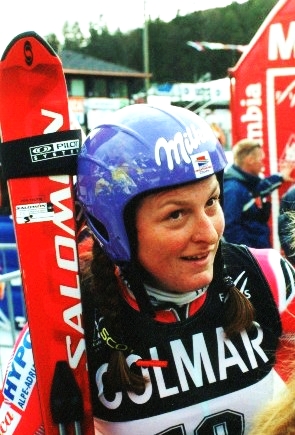
The FIS Alpine Ski World Cup is the top international circuit of alpine skiing competitions, launched in 1966 by a group of ski racing friends and experts which included French journalist Serge Lang and the alpine ski team directors from France and the USA. It was soon backed by International Ski Federation president Marc Hodler during the FIS Alpine World Ski Championships 1966 at Portillo, Chile, and became an official FIS event in the spring of 1967 after the FIS Congress at Beirut, Lebanon.

Giant slalom (GS) is an alpine skiing and alpine snowboarding competitive discipline. It involves racing between sets of poles ("gates") spaced at a greater distance from each other than in slalom but less than in Super-G.

Super giant slalom, or super-G, is a racing discipline of alpine skiing. Along with the faster downhill, it is regarded as a "speed" event, in contrast to the technical events giant slalom and slalom. It debuted as an official World Cup event during the 1983 season and was added to the official schedule of the World Championships in 1987 and the Winter Olympics in 1988.

Janica Kostelić is a Croatian former alpine ski racer. She is a four-time Olympic gold medalist. In addition to the Olympics, she won five gold medals at the World Championships. In World Cup competition, she won thirty individual races, three overall titles, three slalom titles, and four combined titles. Kostelic's accomplishments in professional skiing have led some commentators, writers, and fellow ski racers to regard her as the greatest female ski racer of all time.

Alpine skiing has been contested at every Winter Olympics since 1936, when a combined event was held in Garmisch-Partenkirchen, Germany.
Combined is an event in alpine ski racing. The event format has changed within the last 30 years. A traditional combined competition is a two-day event consisting of one run of downhill and two runs of slalom; each discipline takes place on a separate day. The winner is the skier with the fastest aggregate time. Until the 1990s, a complicated point system was used to determine placings in the combined event. Since then, a modified version, called either a "super combined" or an "Alpine combined", has been run as an aggregate time event consisting of two runs: first, a one-run speed event and then only one run of slalom, with both portions held on the same day.
The 37th World Cup season began in October 2002 on Sölden, Austria, and concluded in March 2003 at the World Cup finals in Lillehammer, Norway. The overall winners were Stephan Eberharter of Austria and Janica Kostelić of Croatia.
The 23rd World Cup season began in November 1988 in Austria and concluded in March 1989 in Japan. The overall champions were Marc Girardelli of Luxembourg and Vreni Schneider of Switzerland. Schneider established the record for victories in a World Cup season, winning a total of 14 races, surpassing the record of 13 established in 1978-79 by the great Swedish skier and three-time overall World Cup champion Ingemar Stenmark.
The 17th season of World Cup competition began in December 1982 in Switzerland and concluded in March 1983 in Japan. For the first time, the overall titles were both won by Americans, Tamara McKinney and Phil Mahre. Mahre won his third consecutive overall World Cup title; McKinney became the first American woman to win the overall title.
The 16th World Cup season began in December 1981 in France and concluded in March 1982, also in France. Phil Mahre of the US repeated as overall champion, the second of his three consecutive titles. Erika Hess of Switzerland won the women's overall title.

Erika Hess is a former World Cup alpine ski racer from Switzerland. One of the best female racers of the 1980s, Hess had 31 World Cup wins, four slalom titles, and two overall titles. She also won six World Championship gold medals between 1982 and 1987, and took bronze in the slalom at the 1980 Winter Olympics at age 17. Hess missed another medal in 1985, when she led after the first run of the slalom at the "Stelvio" course at Bormio, but failed to finish the second leg.

Perrine Marie Pelen is a former World Cup alpine ski racer from France. Born at Boulogne-Billancourt near Paris, she made her World Cup debut at age 16 in December 1976 and won three slalom races that 1977 season.
Irene Epple-Waigel is a German former alpine skier. She won a total of 11 Alpine Skiing World Cup races and two World Cups, in giant slalom and combined. She also won a silver medal at the 1980 Winter Olympic Games in giant slalom. In the 1978 FIS Alpine Skiing World Championships at Garmisch-Partenkirchen she won the silver medal in the downhill. On 9 January 1983 she won the first women's World Cup Super-G race, held in Verbier.
The FIS Alpine World Ski Championships 1982 were held in Schladming, Austria, between 28 January and 7 February 1982. These were the 27th World Championships; the men's races were held at Planai and the women's at Haus im Ennstal.
Women's giant slalom World Cup 1981/1982

The ICF Canoe Slalom World Cup is an annual season-long series of top level races in canoe slalom held under the auspices of the International Canoe Federation. It has been held since 1988 in four canoe and kayak disciplines for men and women. The four original disciplines were men's single canoe (C1), men's double canoe (C2), men's kayak (K1) and women's kayak. A women's single canoe discipline (C1) has been added to the world cup in 2010. The men's C2 event was removed from the world cup series in 2018 and it was replaced by the mixed C2 event. The mixed C2 event only lasted for one season, however. 2018 was also the first time that world cup points were awarded for the kayak cross.
The Women's slalom competition of the Sarajevo 1984 Olympics was held at Jahorina.

Planai is a World Cup ski course, located on the same name mountain and ski resort in Schladming, Styria, Austria, opened in 1973.








